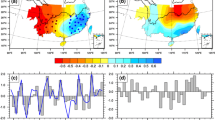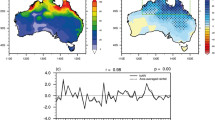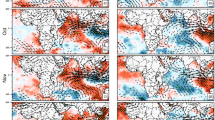Abstract
The positive phase of the subtropical Indian Ocean dipole (SIOD) is one of the climatic modes in the subtropical southern Indian Ocean that influences the austral summer inter-annual rainfall variability in parts of southern Africa. This paper examines austral summer rain-bearing circulation types (CTs) in Africa south of the equator that are related to the positive SIOD and the dynamics through which specific rainfall regions in southern Africa can be influenced by this relationship. Four austral summer rain-bearing CTs were obtained. Among the four CTs, the CT that featured (i) enhanced cyclonic activity in the southwest Indian Ocean; (ii) positive widespread rainfall anomaly in the southwest Indian Ocean; and (iii) low-level convergence of moisture fluxes from the tropical South Atlantic Ocean, tropical Indian Ocean, and the southwest Indian Ocean, over the south-central landmass of Africa, was found to be related to the positive SIOD climatic mode. The relationship also implies that positive SIOD can be expected to increase the amplitude and frequency of occurrence of the aforementioned CT. The linkage between the CT related to the positive SIOD and austral summer homogeneous regions of rainfall anomalies in Africa south of the equator showed that it is the principal CT that is related to the inter-annual rainfall variability of the south-central regions of Africa, where the SIOD is already known to significantly influence its rainfall variability. Hence, through the large-scale patterns of atmospheric circulation associated with the CT, the SIOD can influence the spatial distribution and intensity of rainfall over the preferred landmass through enhanced moisture convergence.
摘 要
副热带印度洋偶极子(SIOD)的正位相是影响南半球夏季南非部分地区降水年际变率的副热带南印度洋气候模态之一. 本文研究了与SIOD正位相相关的南半球夏季赤道以南非洲地区的降水环流型 (CT) 及其影响机制. 共得出四种南半球夏季降水 CT, 其中三种与 SIOD 正位相相关, 其特征分别表现为 (i) 西南印度洋气旋性活动增强, (ii) 西南印度洋大范围的正降水异常, 以及 (iii) 来自热带南大西洋, 热带印度洋和西南印度洋的水汽在非洲中南部大陆上空低层辐合. 这种联系还意味着 SIOD 正位相被认为可以提高上述 CT 的强度和发生频率. 与 SIOD 正位相相关的 CT 和南半球夏季赤道以南非洲地区的降水异常均质区之间的联系表明, 这是与非洲中南部地区降水年际变率相关的最主要的 CT, 而在非洲中南部地区 SIOD 被广泛认识到它显著影响降水变率. 因此, SIOD 可以通过与 CT 联系的大尺度大气环流模态以及增强的水汽辐合从而影响大陆上空降水的空间分布和强度.
Article PDF
Similar content being viewed by others
Avoid common mistakes on your manuscript.
References
Barimalala, R., F. Desbiolles, R. C. Blamey, and C. Reason, 2018: Madagascar influence on the South Indian Ocean convergence zone, the Mozambique Channel trough and southern African Rainfall. Geophys. Res. Lett., 45, 11 380–11 389, https://doi.org/10.1029/2018GL079964.
Barimalala, R., R. C. Blamey, F. Desbiolles, and C. J. C. Reason, 2020: Variability in the Mozambique Channel Trough and impacts on Southeast African rainfall. J. Climate, 33, 749–765, https://doi.org/10.1175/JCLI-D-19-0267.1.
Behera, S. K., and T. Yamagata, 2001: Subtropical SST dipole events in the southern Indian Ocean. Geophys. Res. Lett., 28, 327–330, https://doi.org/10.1029/2000GL011451.
Compagnucci, R. H., and M. B. Richman, 2008: Can principal component analysis provide atmospheric circulation or teleconnection patterns. International Journal of Climatology, 28, 703–726, https://doi.org/10.1002/joc.1574.
Compagnucci, R. H., D. Araneo, and P. O. Canziani, 2001: Principal sequence pattern analysis: A new approach to classifying the evolution of atmospheric systems. International Journal of Climatology, 21(2), 197–217, https://doi.org/10.1002/joc.601.
Cook, K. H., 2000: The South Indian convergence zone and interannual rainfall variability over southern Africa. J. Climate, 13, 3789–3804, https://doi.org/10.1175/1520-0442(2000)013<3789:TSICZA>2.0.CO;2.
Ding, Q. H., E. J. Steig, D. S. Battisti, and J. M. Wallace, 2012: Influence of the tropics on the southern Annular Mode. J. Climate, 25, 6330–6348, https://doi.org/10.1175/JCLI-D-11-00523.1.
Fauchereau, N., S. Trzaska, Y. Richard, P. Roucou, and P. Camberlin, 2003: Sea-surface temperature co-variability in the southern Atlantic and Indian Oceans and its connections with the atmospheric circulation in the southern Hemisphere. International Journal of Climatology, 23, 663–677, https://doi.org/10.1002/joc.905.
Gong, X. F., and M. B. Richman, 1995: On the application of cluster analysis to growing season precipitation data in North America East of the Rockies. J. Climate, 8, 897–931, https://doi.org/10.1175/1520-0442(1995)008<0897:OTAOCA>2.0.CO;2.
Hendrickson, A. E., and P. O. White, 1964: Promax: A quick method for rotation to oblique simple structure. British Journal of Statistical Psychology, 17, 65–70, https://doi.org/10.1111/j.2044-8317.1964.tb00244.x.
Hermes, J. C., and C. J. C. Reason, 2005: Ocean model diagnosis of interannual coevolving SST variability in the South Indian and South Atlantic Oceans. J. Climate, 18, 2864–2882, https://doi.org/10.1175/JCLI3422.1.
Ho, C. H., J. H. Kim, J. H. Jeong, H. S. Kim, and D. L. Chen, 2006: Variation of tropical cyclone activity in the South Indian Ocean: El Niño-Southern Oscillation and Madden-Julian Oscillation effects. J. Geophys. Res., 111, D22101, https://doi.org/10.1029/2006JD007289.
Hoell, A., C. Funk, J. Zinke, and L. Harrison, 2017: Modulation of the southern Africa precipitation response to the El Niño southern Oscillation by the subtropical Indian Ocean Dipole. Climate Dyn., 48, 2529–2540, https://doi.org/10.1007/s00382-016-3220-6.
Huang, B. Y., and Coauthors, 2017: Extended reconstructed sea surface temperature, version 5 (ERSSTv5): Upgrades, validations, and intercomparisons. J. Climate, 30, 8179–8205, https://doi.org/10.1175/JCLI-D-16-0836.1.
Huth, R., 1996: An intercomparison of computer-assisted circulation classification methods. International Journal of Climatology, 16, 893–922, https://doi.org/10.1002/(SICI)1097-0088(199608)16:8<893::AID-JOC51>3.0.CO;2-Q.
Ibebuchi, C. C., 2021a: On the relationship between circulation patterns, the southern Annular Mode, and rainfall variability in Western Cape. Atmosphere, 12, 753, https://doi.org/10.3390/atmos12060753.
Ibebuchi, C. C., 2021b: Circulation pattern controls of wet days and dry days in Free State, South Africa. Meteorol. Atmos. Phys., 133, 1469–1480, https://doi.org/10.1007/s00703-021-00822-0.
Ibebuchi, C. C., 2021c: Revisiting the 1992 severe drought episode in South Africa: The role of El Niño in the anomalies of atmospheric circulation types in Africa South of the equator. Theor. Appl. Climatol., 146, 723–740, https://doi.org/10.1007/s00704-021-03741-7.
Ibebuchi, C. C., 2022a: Can synoptic patterns influence the track and formation of tropical cyclones in the Mozambique Channel. AIMS Geosciences, 8, 33–51, https://doi.org/10.3934/geosci.2022003.
Ibebuchi, C. C., 2022b: Patterns of atmospheric circulation in western Europe linked to heavy rainfall in Germany: Preliminary analysis into the 2021 heavy rainfall episode. Theor. Appl. Climatol, 148, 269–283, https://doi.org/10.1007/s00704-022-03945-5.
Japan Meteorological Agency., 2006: Characteristics of Global Sea surface temperature analysis data (COBE-SST) for climate use. Vol. 12. Monthly Report on Climate System Separated, 116pp.
Jones, W. P., 1999: First- and second-order conservative remapping schemes for grids in spherical coordinates. Mon. Wea. Rev., 127, 2204–2210, https://doi.org/10.1175/1520-0493(1999)127<2204:FASOCR>2.0.CO;2.
Kalnay, E., and Coauthors, 1996: The NCEP/NCAR 40-year reanalysis project. Bull. Amer. Meteor. Soc., 77, 437–472, https://doi.org/10.1175/1520-0477(1996)077<0437:TNYRP>2.0.CO;2.
Kidson, J. W. 1997: The utility of surface and upper air data in synoptic climatological specification of surface climatic variables. Int. J. Climatol., 17, 399–413. https://doi.org/10.1002/(SICI)1097-0088(19970330)17:4%3c399::AID-JOC108%3e3.0.CO;2-M.
Lazenby, M. J., M. C. Todd, and Y. Wang, 2016: Climate model simulation of the South Indian Ocean Convergence Zone: Mean state and variability. Climate Research, 68, 59–71, https://doi.org/10.3354/cr01382.
Lim, E. P., and H. H. Hendon, 2017: Causes and predictability of the negative Indian Ocean Dipole and its impact on La Niña during 2016. Scientific Reports, 7, 12619, https://doi.org/10.1038/s41598-017-12674-z.
Manatsa, D., W. Chingombe, and C. H. Matarira, 2008: The impact of the positive Indian Ocean dipole on Zimbabwe droughts. International Journal of Climatology, 28, 2011–2029, https://doi.org/10.1002/joc.1695.
Meehl, G. A., 1987: The annual cycle and interannual variability in the tropical Pacific and Indian Ocean regions. Mon. Wea. Rev., 115, 27–50, https://doi.org/10.1175/1520-0493(1987)115<0027:TACAIV>2.0.CO;2.
Morioka, Y., T. Tozuka, and T. Yamagata T, 2010: Climate variability in the southern Indian Ocean as revealed by self-organizing maps. Climate Dyn., 35, 1059–1072, https://doi.org/10.1007/s00382-010-0843-x.
Morioka, Y., K. Takaya, S. K. Behera, and Y. Masumoto, 2015: Local SST impacts on the summertime Mascarene high variability. J. Climate, 28(2), 678–694, https://doi.org/10.1175/JCLI-D-14-00133.1.
Rapolaki, R. S., R. C. Blamey, J. C. Hermes, and C. J. C. Reason, 2020: Moisture sources associated with heavy rainfall over the Limpopo River Basin, southern Africa. Climate Dyn., 55, 1473–1487, https://doi.org/10.1007/s00382-020-05336-w.
Reason, C. J. C., 1999: Interannual warm and cool events in the subtropical/mid-latitude South Indian Ocean region. Geophys. Res. Lett., 26, 215–218, https://doi.org/10.1029/1998GL900285.
Reason, C. J. C., 2001: Subtropical Indian Ocean SST dipole events and southern African rainfall. Geophys. Res. Lett., 28, 2225–2227, https://doi.org/10.1029/2000GL012735.
Reason, C. J. C., 2002: Sensitivity of the southern African circulation to dipole sea-surface temperature patterns in the South Indian Ocean. International Journal of Climatology, 22, 377–393, https://doi.org/10.1002/joc.744.
Reason, C. J. C., 2016: The Bolivian, Botswana, and Bilybara highs and southern Hemisphere drought/floods. Geophys. Res. Lett., 43, 1280–1286, https://doi.org/10.1002/2015GL067228.
Reason, C. J. C., and H. Mulenga, 1999: Relationships between South African rainfall and SST anomalies in the southwest Indian Ocean. International Journal of Climatology, 19, 1651–1673, https://doi.org/10.1002/(SICI)1097-0088(199912)19:15<1651::AID-JOC439>3.0.CO;2-U.
Reason, C. J. C., and M. Rouault, 2005: Links between the Antarctic Oscillation and winter rainfall over western South Africa. Geophys. Res. Lett., 32, L07705, https://doi.org/10.1029/2005GL022419.
Reason, C. J. C., and D. Jagadheesha, 2005: A model investigation of recent ENSO impacts over southern Africa. Meteorol. Atmos. Phys., 89, 181–205, https://doi.org/10.1007/s00703-005-0128-9.
Reason, C. J. C., and S. Smart, 2015: Tropical South East Atlantic warm events and associated rainfall anomalies over southern Africa. Frontiers in Environmental Science, 3, 24, https://doi.org/10.3389/fenvs.2015.00024.
Richman, M. B., 1981: Obliquely rotated principal components: An improved meteorological map typing technique. J. Appl. Meteor., 20, 1145–1159, https://doi.org/10.1175/1520-0450(1981)020<1145:ORPCAI>2.0.CO;2.
Richman, M. B., 1986: Rotation of principal components. J. Climate, 6, 293–335, https://doi.org/10.1002/joc.3370060305.
Richman, M. B., and P. J. Lamb, 1985: Climatic pattern analysis of three- and seven-day summer rainfall in the Central United States: Some methodological considerations and a regionalization. J. Climate Appl. Meteor., 24, 1325–1343, https://doi.org/10.1175/1520-0450(1985)024<1325:CPAOTA>2.0.CO;2.
Richman, M. B., and X. F. Gong, 1999: Relationships between the definition of the hyperplane width to the fidelity of principal component loading patterns. J. Climate, 12, 1557–1576, https://doi.org/10.1175/1520-0442(1999)012<1557:RBT-DOT>2.0.CO;2.
Saji, N. H., B. N. Goswami, P. N. Vinayachandran, and T. Yamagata, 1999: A dipole mode in the tropical Indian Ocean. Nature, 401, 360–363, https://doi.org/10.1038/43854.
Thompson, D. W. J., and J. M. Wallace, 2000: Annular modes in the extratropical circulation. Part I: Month-to-month variability. J. Climate, 13, 1000–1016, https://doi.org/10.1175/1520-0442(2000)013<1000:AMITEC>2.0.CO;2.
Thorne, V., P. Coakeley, D. Grimes, and G. Dugdale, 2001: Comparison of TAMSAT and CPC Rainfall Estimates with rain-gauges, for southern Africa. Int. J. Remote. Sens., 22(10), 1951–1974, https://doi.org/10.1080/01431160118816.
Vigaud, N., Y. Richard, M. Rouault, and N. Fauchereau, 2009: Moisture transport between the South Atlantic Ocean and Southern Africa: Relationships with summer rainfall and associated dynamics. Climate Dyn., 32, 113–123, https://doi.org/10.1007/s00382-008-0377-7.
Walker, N. D., 1990: Links between South African summer rainfall and temperature variability of the Agulhas and Benguela Current systems. J. Geophys. Res., 95, 3297–3319, https://doi.org/10.1029/JC095iC03p03297.
Xie, P. P., M. Y. Chen, S. Yang, A. Yatagai, T. Hayasaka, Y. Fukushima, and C. M. Liu, 2007: A gauge-based analysis of daily precipitation over East Asia. Journal of Hydrometeorology, 8, 607–626, https://doi.org/10.1175/JHM583.1.
Xue, F., H. J. Wang, and J. H. He, 2003: Interannual variability of Mascarene High and Australian High and their influences on summer rainfall over East Asia. Chinese Science Bulletin, 48, 492–497, https://doi.org/10.1007/BF03183258.
Yuan, C. X., T. Tozuka, W. A. Landman, and T. Yamagata, 2014a: Dynamical seasonal prediction of southern African summer precipitation. Climate Dyn., 42, 3357–3374, https://doi.org/10.1007/s00382-013-1923-5.
Yuan, C. X., T. Tozuka, J.-J. Luo, and T. Yamagata, 2014b: Predictability of the subtropical dipole modes in a coupled ocean-atmosphere model. Climate Dyn., 42, 1291–1308, https://doi.org/10.1007/s00382-013-1704-1.
Acknowledgements
The assistance of NOAA/OAR/ESRL PSL, Boulder, Colorado, USA in accessing the NCEP/NCAR reanalysis data sets and CPC precipitation data sets provided on their website at https://psl.noaa.gov/ is greatly appreciated.
Funding
Funding: Open access funding enabled and organized by Projekt DEAL.
Author information
Authors and Affiliations
Corresponding author
Ethics declarations
Conflict of interest: There are no conflicts of interest.
Additional information
Article Highlights
• The positive phase of the subtropical Indian Ocean dipole modulates circulation patterns in Africa south of the equator.
• Through the modulation of circulation patterns, summer rainfall variability at the south-central parts of Africa are impacted.
• Enhanced convective activity in parts of the southwest Indian Ocean contribute to above-average rainfall at the south-central parts of Africa.
Rights and permissions
Open Access This article is licensed under a Creative Commons Attribution 4.0 International License, which permits use, sharing, adaptation, distribution and reproduction in any medium or format, as long as you give appropriate credit to the original author(s) and the source, provide a link to the Creative Commons licence, and indicate if changes were made. The images or other third party material in this article are included in the article’s Creative Commons licence, unless indicated otherwise in a credit line to the material. If material is not included in the article’s Creative Commons licence and your intended use is not permitted by statutory regulation or exceeds the permitted use, you will need to obtain permission directly from the copyright holder. To view a copy of this licence, visit http://creativecommons.org/licenses/by/4.0/.
About this article
Cite this article
Ibebuchi, C.C. Circulation Patterns Linked to the Positive Sub-Tropical Indian Ocean Dipole. Adv. Atmos. Sci. 40, 110–128 (2023). https://doi.org/10.1007/s00376-022-2017-2
Received:
Revised:
Accepted:
Published:
Issue Date:
DOI: https://doi.org/10.1007/s00376-022-2017-2




